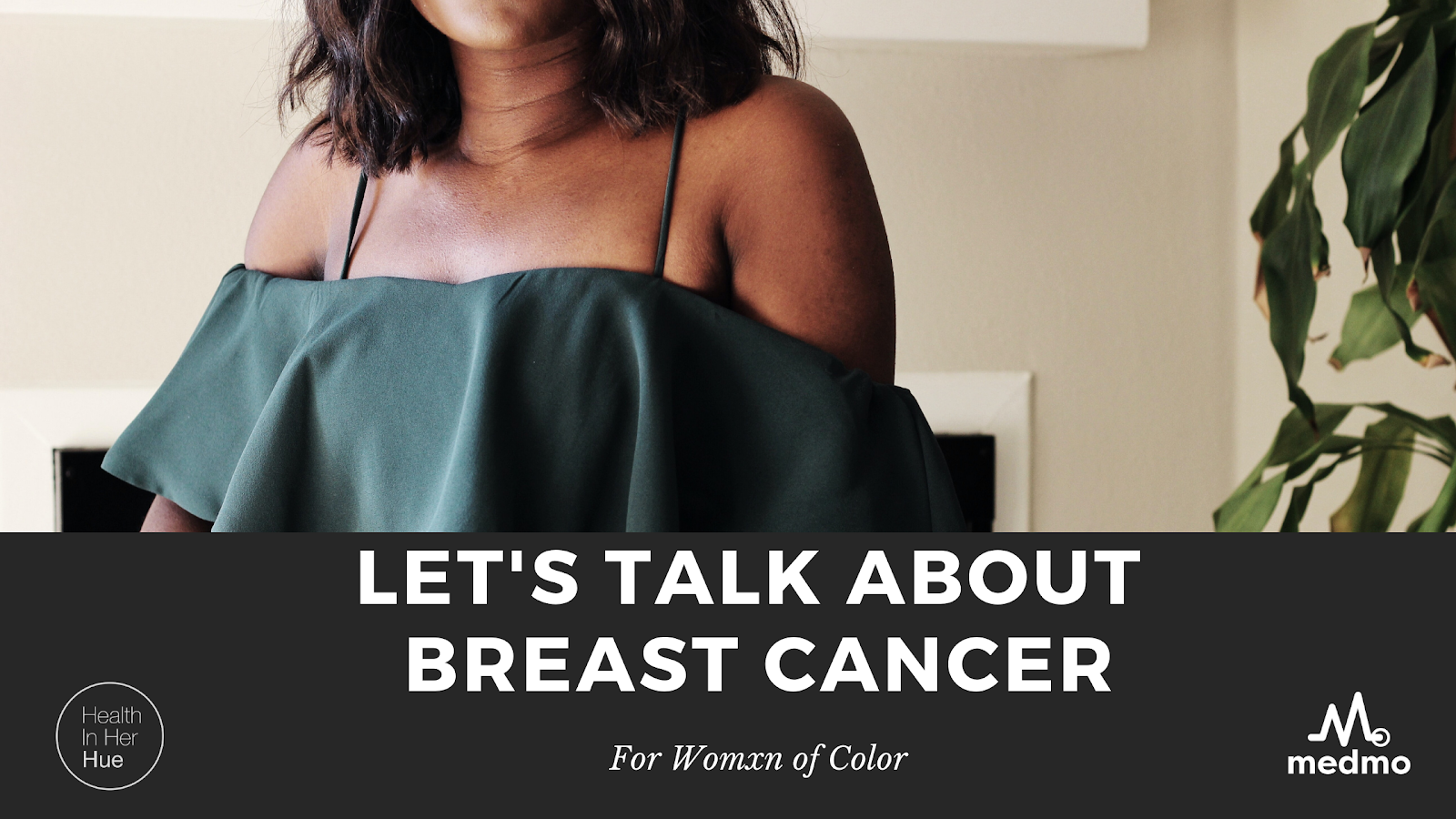
Let’s Talk About Breast Cancer For Womxn of Color
October is Breast Cancer Awareness Month and with the Avon walks and pink ribbons comes the important topic of breast cancer screenings. After skin cancer, breast cancer is the most commonly diagnosed cancer among women in the United States – although men are not excluded from being diagnosed. There are more than 200,000 US cases of breast cancer each year and although it is treatable, lab testing and medical imaging are always required.
Health in Her Hue has partnered with Medmo to highlight research examining breast cancer prevention, screening and treatment for Black women.
Breast cancer is not discriminatory in its reach, but its survival rate among Black women and women of color is evidence of how difficult it is to receive uniform treatment in healthcare. White women of European descent are more likely to be diagnosed with the disease but Black women are diagnosed with more aggressive types of breast cancer and have a higher mortality rate from it. Mammography screenings are the most common, non-invasive way to diagnose breast cancer and, along with follow-up tests and treatment, they can reduce the chance of dying from the disease. Although there are differing opinions among medical professionals about when women should start receiving breast cancer screenings, Black women are among those considered at high risk for breast cancer and as such, the recommended age to start screening is 30. Despite this, there is still a large difference in screening rates among women.

The main factor behind differences in screening rates is healthcare. People without insurance are much less likely to get screenings and mammograms are no exception. In a study published in 2018, women between the ages of 50-74 were surveyed about the frequency of their medical care. 39% of those without health insurance reported to have gotten a mammography screening within the last two years while 75% of those with insurance reported the same. The heavy cost associated with screenings makes most people think that they can only afford it if they have insurance. Other barriers include lack of access to consistent health care, lack of physician recommendation, lack of access to childcare and ability to take time off from work. The disparity in screening helps to explain why breast cancer mortality is 39% higher in Black and African American women than in white women, yet the incidence rate (rate of new cases) is higher for the latter.
The history of public health is of note when discussing the medical distrust that continues to perpetuate through the Black community, specifically with Black women. For example, Henrietta Lacks was a woman whose cervical cells were taken without informed consent and utilized for experiments ranging from long-term effects of radiation to the live polio vaccine. Her cells have been commercialized and have generated millions of dollars in profit for the medical researchers who patented the cellular culture, all without her consent. This is not the only case where Black women have been subjected to clinical research abuse. As a byproduct of these systemic issues, Black women have limited trust in their medical providers, researchers, and procedural screenings. Interpersonal trust between medical providers and their patients have shown to be an important determinant of health outcomes, therefore medical distrust serves as a predisposition to disease risk. Health in Her Hue has made it their mission to bridge the gap between women of color in need of sound and empathetic medical care and providers capable of servicing their needs.

Henrietta Lacks — her fictional HBO character (left) and the real woman behind the cells that changed science. HBO/Harvard University Source: Vox.com
Medmo serves as a digital tool to connect patients to high-quality imaging in their area. Their primary mission is to empower patient choice, and provide transparency as they navigate their health care decisions. Similar to booking a dinner reservation, booking a medical imaging appointment on Medmo takes just a few minutes.
Medical imaging can be expensive because it requires more coordination between patients and providers; but that doesn’t mean that patients have to get the short-end of the stick. Many doctors’ offices and screening centers offer steep discounts if you pay in cash. They do this to avoid the additional time and money involved in dealing with insurance companies and it helps you out by saving you up to hundreds in costs. Even those with insurance shouldn’t rule out self-pay as a more affordable option for medical imaging. When thinking through options, it’s important to understand how most insurance works, specifically insurance deductibles. A deductible is the amount of money insurance policy-holders need to pay before their insurance kicks in. For example, if your insurance policy has a $500 deductible, you would need to pay for $500 worth of medical expenses yourself, before insurance kicks in. If you have insurance, sometimes paying a cheaper screening price can even go towards your deductible.
Mammograms and other types of breast cancer screenings tend to be intimidating and combined with medical distrust and lack of representation in physicians, it can serve as a dual-barrier to receiving care and treatment. Health in Her Hue and Medmo’s partnership aims to bridge the gap between the aforementioned barriers to care: access to medical imaging and culturally competent providers. Through this collaboration, we intend to educate, empower, and connect women of color to high quality medical imaging and do our part to prevent the high prevalence and mortality rates of breast cancer in women of color.
This piece was written in partnership with Medmo.
More Content
Breast Health
Black Breastfeeding Week: Breaking Barriers and Bridging the Racial Gap
National Breastfeeding Month is commemorated annually in...











